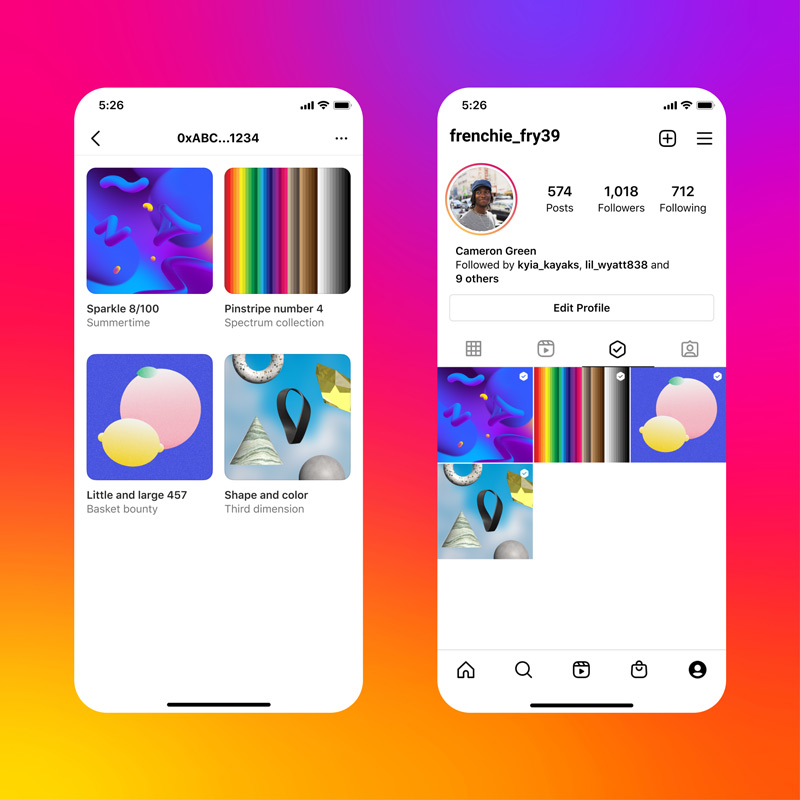Expanding further into the metaverse is Meta, technology powerhouse behind our popular social media and messaging platforms: think Facebook, Whatsapp and most pertinently, Instagram. The photo-sharing platform has rapidly evolved in the past two years with the introduction of key additions to the interface such as Reels, 3D Avatars and the Creator Marketplace, designed to make the working relationship between content creators and potential brand partners a seamless one. Most recently, the platform launched a beta testing of the full-screen feed that combines reels and photos all within one’s feed—a move that aims to adjust to the overwhelming consumer shift in preference for the video format. But amidst the multitude of smaller functionality updates and aesthetic changes, Meta has effectively taken their first step to unlocking the potential of the metaverse: where creators and collectors can now share the non-fungible tokens (NFTs) they’ve bought or sold, on the public interface.

How are they doing this, you ask? Enter: digital wallets. Whilst digital wallets are no longer a newfangled concept in the world of contactless payments, Meta’s latest move to connect third-party crypto wallets with the social app is a formative step towards integrating one’s activities in the metaverse with one’s real-life identity. These digital wallets, such as Rainbow, MetaMask and Trust Wallet are all actually cryptocurrency wallets, that have been enabling the trade of NFT tokens and assets within the Web3 world, on decentralised blockchain platforms such as Ethereum. Through a link-up of one’s digital crypto wallet with Instagram, both NFT collectors and creators alike will be able to choose if they would like to share the NFTs that they’ve purchased or sold on the blockchain. This is done via an active organisation of public data available from these open blockchain platforms—namely Ethereum and Polygon for now—to identify the current ownership of the digital collectibles.
View this post on Instagram
This changes things for the everyday social consumer on Instagram. With this new introduction that is currently underway, NFTs and digital collectibles are made more accessible to a diverse range of individuals. Creators and collectors can share more about the artworks or NFTs they’ve sold or purchased, especially since a public description can be written regarding the collectible. As more and more profiles begin to use this function, adding one’s digital collectible to their profile can be seen as contributing to an online museum—where viewers can learn more about the NFT artwork from behind their own screens. In addition, the automatic tagging function ensures that creators can be given full credit for their work, hence opening up their market reach as the barriers to entry are minimised with no fees attached to posting or sharing one’s digital collectibles.

The essence of Meta’s move can be seen as one that brings the still obscure world of NFTs and Web3 to a global audience; after all, one would be hard-pressed to find someone who doesn’t own an Instagram account in this digital age. Even if an individual doesn’t own a digital crypto wallet, they would still be able to ‘view’ the digital collectible and develop a peripheral interest in it.
Whilst the compatible digital wallets that can be linked to Instagram are currently still limited, more and more individuals will eventually be able to connect their crypto wallets as Meta opens up accessibility to more third-party wallets. Head of Instagram, Adam Mosseri himself acknowledges that “there’s a lot more functionality that we’re going to need to build over time” but they want to “start small and learn from the community”—to eventually move nearer to the fluid ethos that the decentralised world of NFTs and blockchain technology offers. Certainly, there is much to be built on, but with this first stone being rolled out, it’s a whole new world of access that Meta is heading towards.





